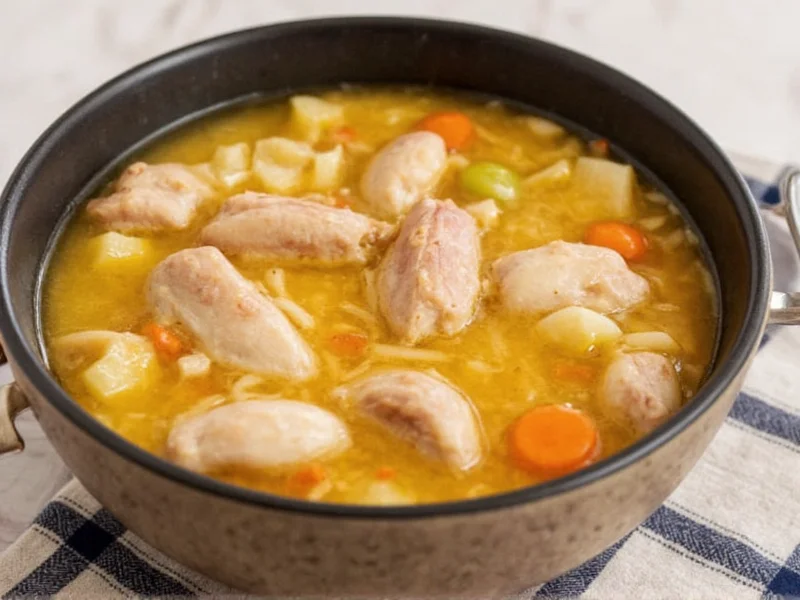The best chicken for soup is a whole chicken or bone-in cuts like backs, necks, and wings. These parts contain high collagen content that transforms into gelatin during cooking, creating rich flavor and velvety texture. Bone-in chicken thighs and drumsticks also work well for hearty soups, while breast meat is better added near the end to prevent drying out.
Why Bone-In Chicken Makes Superior Soup
When making chicken soup, the cut you choose directly impacts flavor depth and broth quality. Professional chefs and home cooks consistently prefer bone-in chicken because bones release marrow and collagen during simmering. As collagen breaks down, it creates natural gelatin that gives soup its luxurious mouthfeel and body. This process can't be replicated with boneless cuts alone.
Top Chicken Cuts for Soup Compared
| Chicken Cut | Flavor Contribution | Texture Benefit | Best For |
|---|---|---|---|
| Whole Chicken (3-4 lbs) | ★★★★★ | ★★★★★ | Classic chicken soup, family batches |
| Chicken Backs/Necks | ★★★★☆ | ★★★★★ | Restaurant-style broth, stock making |
| Bone-in Thighs | ★★★★☆ | ★★★★☆ | Hearty stews, rustic soups |
| Breast Meat | ★★★☆☆ | ★★☆☆☆ | Add near end for light soups |
| Wings | ★★★★☆ | ★★★★☆ | Quick broth, Asian-inspired soups |
Understanding Collagen's Role in Soup Quality
Chicken soup's magic happens through science. Connective tissues in bone-in cuts contain collagen, which converts to gelatin at 160°F (71°C). This transformation creates that signature silky texture professional soups are known for. Boneless chicken breasts lack these connective tissues, resulting in thinner, less satisfying broth. For maximum collagen extraction, simmer bones for 2-4 hours—longer than you'd cook meat for eating.
Practical Tips for Perfect Chicken Soup
Start with cold water when making stock. Adding chicken to cold liquid allows gradual temperature increase, extracting more flavor compounds. Skim foam during the first 20 minutes for crystal-clear broth. For richer flavor, roast bones at 400°F (204°C) for 30 minutes before simmering—a technique called "fond de poulet" in French cuisine.
When using whole chicken, remove meat after 45 minutes of simmering to prevent overcooking, then return bones to continue broth development. Shred the cooked meat and add back to finished soup. This method gives you both perfectly cooked meat and deeply flavored broth.
Avoiding Common Chicken Soup Mistakes
Many home cooks make these errors: boiling instead of simmering (causes cloudy broth), adding salt too early (concentrates as liquid reduces), and using only breast meat (creates bland results). For authentic flavor, include aromatic vegetables like onions, carrots, and celery—but add them after the first hour to prevent bitterness from overcooking.
Specialty Soup Applications
Asian chicken soups often use whole young chickens or Cornish hens for delicate flavor. For tortilla soup, roasted bone-in thighs provide smoky depth. When making chicken noodle soup, a combination of backs and breast meat delivers both rich broth and tender meat. The best chicken bones for soup stock come from heritage breed chickens, which have higher collagen content than commercial breeds.
Storing and Using Leftover Components
After making soup, save leftover bones for quick stock—simmer 1 hour with water and aromatics for instant broth. Strain and freeze broth in ice cube trays for convenient portioning. Shredded chicken works in salads, sandwiches, or as taco filling. Properly stored, homemade chicken broth lasts 5 days refrigerated or 6 months frozen.
Frequently Asked Questions
Can I use rotisserie chicken for soup?
Yes, but with limitations. Rotisserie chicken provides convenient pre-cooked meat, but the bones have already released most collagen. For best results, use the meat in finished soup and supplement with fresh bones or backs for broth depth. The best chicken for soup stock requires raw bones for maximum flavor extraction.
How long should I simmer chicken bones for soup?
Simmer chicken bones for 2-4 hours for optimal flavor and texture. Shorter times (1-2 hours) work for light broths, while 3-4 hours extracts maximum collagen for rich, gelatinous stock. Avoid exceeding 4 hours as prolonged cooking can create bitter flavors. The ideal simmering time for chicken soup bones balances extraction without deterioration.
Why does my chicken soup lack flavor?
Common causes include using only boneless chicken breasts, insufficient simmering time, or adding salt too late. For deeper flavor, use bone-in cuts, simmer 3+ hours, and season in stages. The best chicken soup broth requires proper technique—starting with cold water, skimming impurities, and using adequate bones-to-water ratio (1 pound bones per quart water).
Which chicken cut makes the clearest broth?
Chicken backs and necks produce the clearest broth when handled properly. Start with cold water, bring to gentle simmer (not boil), and skim foam during first 20 minutes. Strain through cheesecloth for professional results. The best chicken bones for clear soup stock come from younger birds with less fat content.
Can I use frozen chicken for soup?
Yes, but thawing first yields better results. Frozen chicken added directly to soup releases excess water, diluting flavor. For best texture and concentration, thaw chicken completely before use. The ideal chicken for soup maintains proper water-to-meat ratio, which frozen chicken disrupts when added unthawed.











 浙公网安备
33010002000092号
浙公网安备
33010002000092号 浙B2-20120091-4
浙B2-20120091-4